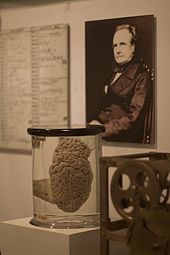- Charles Babbage
-
Charles Babbage 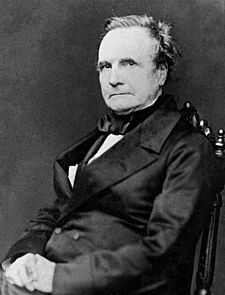
Charles Babbage in 1860Born 26 December 1791
London, EnglandDied 18 October 1871 (aged 79)
Marylebone, London, EnglandNationality English Fields Mathematics, analytical philosophy, computer science Institutions Trinity College, Cambridge Alma mater Peterhouse, Cambridge Known for Mathematics, computing Signature

Charles Babbage, FRS (26 December 1791 – 18 October 1871)[1] was an English mathematician, philosopher, inventor and mechanical engineer who originated the concept of a programmable computer.[2] Considered a "father of the computer",[3] Babbage is credited with inventing the first mechanical computer that eventually led to more complex designs.[4] Parts of his uncompleted mechanisms are on display in the London Science Museum. In 1991, a perfectly functioning difference engine was constructed from Babbage's original plans. Built to tolerances achievable in the 19th century, the success of the finished engine indicated that Babbage's machine would have worked. Nine years later, the Science Museum completed the printer Babbage had designed for the difference engine.
Contents
Birth
Babbage's birthplace is disputed, but he was most likely born at 44 Crosby Row, Walworth Road, London, England. A blue plaque on the junction of Larcom Street and Walworth Road commemorates the event.[5]
His date of birth was given in his obituary in The Times as 26 December 1792. However after the obituary appeared, a nephew wrote to say that Charles Babbage was born one year earlier, in 1791. The parish register of St. Mary's Newington, London, shows that Babbage was baptised on 6 January 1792, supporting a birth year of 1791.[6][7][8]
Babbage's father, Benjamin Babbage, was a banking partner of the Praeds who owned the Bitton Estate in Teignmouth. His mother was Betsy Plumleigh Teape. In 1808, the Babbage family moved into the old Rowdens house in East Teignmouth, and Benjamin Babbage became a warden of the nearby St. Michael's Church.
Education
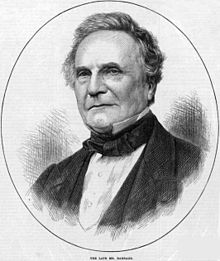 The Illustrated London News (4 November 1871).[9]
The Illustrated London News (4 November 1871).[9]
His father's money allowed Charles to receive instruction from several schools and tutors during the course of his elementary education. Around the age of eight he was sent to a country school in Alphington near Exeter to recover from a life-threatening fever. His parents ordered that his "brain was not to be taxed too much " and Babbage felt that "this great idleness may have led to some of my childish reasonings." For a short time he attended King Edward VI Grammar School in Totnes, South Devon, but his health forced him back to private tutors for a time.[10] He then joined a 30-student Holmwood academy, in Baker Street, Enfield, Middlesex under the Reverend Stephen Freeman. The academy had a well-stocked library that prompted Babbage's love of mathematics. He studied with two more private tutors after leaving the academy. Of the first, a clergyman near Cambridge, Babbage said, "I fear I did not derive from it all the advantages that I might have done."[citation needed] The second was an Oxford tutor from whom Babbage learned enough of the Classics to be accepted to Cambridge.
Babbage arrived at Trinity College, Cambridge in October 1810.[11] He had read extensively in Leibniz, Joseph Louis Lagrange, Thomas Simpson, and Lacroix and was seriously disappointed in the mathematical instruction available at Cambridge. In response, he, John Herschel, George Peacock, and several other friends formed the Analytical Society in 1812. Babbage, Herschel, and Peacock were also close friends with future judge and patron of science Edward Ryan. Babbage and Ryan married two sisters.[12] As a student, Babbage was also a member of other societies such as the Ghost Club, concerned with investigating supernatural phenomena, and the Extractors Club, dedicated to liberating its members from the madhouse, should any be committed to one.[13][14]
In 1812 Babbage transferred to Peterhouse, Cambridge.[11] He was the top mathematician at Peterhouse, but did not graduate with honours. He instead received an honorary degree without examination in 1814.
Marriage, family, death
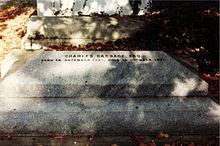 Grave of Charles Babbage at Kensal Green Cemetery
Grave of Charles Babbage at Kensal Green Cemetery
On 25 July 1814, Babbage married Georgiana Whitmore at St. Michael's Church in Teignmouth, Devon. The couple lived at Dudmaston Hall,[15] Shropshire (where Babbage engineered the central heating system), before moving to 5 Devonshire Street, Portland Place, London.
Charles and Georgiana had eight children,[16] but only four — Benjamin Herschel, Georgiana Whitmore, Dugald Bromhead and Henry Prevost — survived childhood. Charles' wife Georgiana died in Worcester on 1 September 1827, the same year as his father, their second son (also named Charles) and their newborn son Alexander. His subsequent decision to spend a year travelling on the Continent incurred a delay in his machines' construction.
Charles Babbage died at age 79 on 18 October 1871, and was buried in London's Kensal Green Cemetery. According to Horsley, Babbage died "of renal inadequacy, secondary to cystitis."[17] In 1983 the autopsy report for Charles Babbage was discovered and later published by his great-great-grandson.[18][19] A copy of the original is also available.[20] Half of Babbage's brain is preserved at the Hunterian Museum in the Royal College of Surgeons in London.[21] The other half of Babbage's brain is on display in the Science Museum, London.[22]
His youngest son, Henry Prevost Babbage (1824–1918), went on to create six working difference engines based on his father's designs,[23] one of which was sent to Harvard University where it was later discovered by Howard H. Aiken, pioneer of the Harvard Mark I. Henry Prevost's 1910 Analytical Engine Mill, previously on display at Dudmaston Hall, is now on display at the Science Museum.[24]
Design of computers
“ In 1812 he was sitting in his rooms in the Analytical Society looking at a table of logarithms, which he knew to be full of mistakes, when the idea occurred to him of computing all tabular functions by machinery. The French government had produced several tables by a new method. Three or four of their mathematicians decided how to compute the tables, half a dozen more broke down the operations into simple stages, and the work itself, which was restricted to addition and subtraction, was done by eighty computers who knew only these two arithmetical processes. Here, for the first time, mass production was applied to arithmetic, and Babbage was seized by the idea that the labours of the unskilled computers could be taken over completely by machinery which would be quicker and more reliable.
” —B. V. Bowden, Faster than thought, Pitman
Babbage's machines were among the first mechanical computers, although they were not actually completed, largely because of funding problems and personality issues. He directed the building of some steam-powered machines that achieved some success, suggesting that calculations could be mechanised. Although Babbage's machines were mechanical and unwieldy, their basic architecture was very similar to a modern computer. The data and program memory were separated, operation was instruction based, the control unit could make conditional jumps and the machine had a separate I/O unit. For more than ten years he received government funding for his project, which amounted to £17,000.00, but eventually the Treasury lost confidence in Babbage.[25]
Difference engine
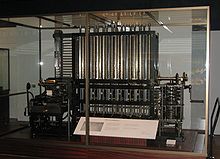 The Science Museum's Difference Engine #2, built from Babbage's design
The Science Museum's Difference Engine #2, built from Babbage's design Main article: Difference engine
Main article: Difference engineIn Babbage's time, numerical tables were calculated by humans who were called 'computers', meaning "one who computes", much as a conductor is "one who conducts". At Cambridge, he saw the high error-rate of this human-driven process and started his life's work of trying to calculate the tables mechanically. He began in 1822 with what he called the difference engine, made to compute values of polynomial functions. Unlike similar efforts of the time, Babbage's difference engine was created to calculate a series of values automatically. By using the method of finite differences, it was possible to avoid the need for multiplication and division.
At the beginning of the 1820s, Babbage worked on a prototype of his first difference engine. Some parts of this prototype still survive in the Museum of the History of Science in Oxford.[26] This prototype evolved into the "first difference engine." It remained unfinished and the completed fragment is located at the Science Museum in London. This first difference engine would have been composed of around 25,000 parts, weighed fifteen tons (13,600 kg), and been 8 ft (2.4 m) tall. Although Babbage received ample funding for the project, it was never completed. He later designed an improved version,"Difference Engine No. 2", which was not constructed until 1989–91, using Babbage's plans and 19th century manufacturing tolerances. It performed its first calculation at the London Science Museum returning results to 31 digits, far more than the average modern pocket calculator.
Completed models
The London Science Museum has constructed two Difference Engines, according to Babbage's plans for the Difference Engine No 2. One is owned by the museum; the other, owned by technology multimillionaire Nathan Myhrvold, went on exhibit at the Computer History Museum[27] in Mountain View, California on 10 May 2008.[28] The two models that have been constructed are not replicas; until the assembly of the first Difference Engine No. 2 by the London Science Museum, no model of it existed.
Analytical engine
Main article: analytical engineSoon after the attempt at making the difference engine crumbled, Babbage started designing a different, more complex machine called the Analytical Engine. The engine is not a single physical machine but a succession of designs that he tinkered with until his death in 1871. The main difference between the two engines is that the Analytical Engine could be programmed using punched cards. He realised that programs could be put on these cards so the person had only to create the program initially, and then put the cards in the machine and let it run. The analytical engine would have used loops of Jacquard's punched cards to control a mechanical calculator, which could formulate results based on the results of preceding computations. This machine was also intended to employ several features subsequently used in modern computers, including sequential control, branching, and looping, and would have been the first mechanical device to be Turing-complete.
Ada Lovelace, an impressive mathematician and one of the few people who fully understood Babbage's ideas, created a program for the Analytical Engine. Had the Analytical Engine ever actually been built, her program would have been able to calculate a sequence of Bernoulli numbers. Based on this work, Lovelace is now widely credited with being the first computer programmer.[29] In 1979, a contemporary programming language was named Ada in her honour.
Researchers in Britain are embarking on a 10-year, multimillion-dollar project to construct Babbage's Analytical Engine.[30]
Modern adaptations
While the abacus and mechanical calculator have been replaced by electronic calculators using microchips, the recent advances in MEMs and nanotechnology have led to recent high-tech experiments in mechanical computation. The benefits suggested include operation in high radiation or high temperature environments.[31] These modern versions of mechanical computation were highlighted in the magazine The Economist in its special "end of the millennium" black cover issue in an article entitled "Babbage's Last Laugh".[32]
Other accomplishments
In 1824, Babbage won the Gold Medal of the Royal Astronomical Society "for his invention of an engine for calculating mathematical and astronomical tables". He was a founding member of the society and one of its oldest living members on his death in 1871.
From 1828 to 1839 Babbage was Lucasian Professor of Mathematics at Cambridge. He contributed largely to several scientific periodicals, and was instrumental in founding the Astronomical Society in 1820 and the Statistical Society in 1834. However, he dreamt of designing mechanical calculating machines.
I was sitting in the rooms of the Analytical Society, at Cambridge, my head leaning forward on the table in a kind of dreamy mood, with a table of logarithms lying open before me. Another member, coming into the room, and seeing me half asleep, called out, "Well, Babbage, what are you dreaming about?" to which I replied "I am thinking that all these tables" (pointing to the logarithms) "might be calculated by machinery".
Babbage was elected a Foreign Honorary Member of the American Academy of Arts and Sciences in 1832.[33] In 1837, responding to the Bridgewater Treatises, of which there were eight, he published his Ninth Bridgewater Treatise, On the Power, Wisdom and Goodness of God, as manifested in the Creation, putting forward the thesis that God had the omnipotence and foresight to create as a divine legislator, making laws (or programs) which then produced species at the appropriate times, rather than continually interfering with ad hoc miracles each time a new species was required. The book is a work of natural theology, and incorporates extracts from correspondence he had been having with John Herschel on the subject.
Babbage also achieved notable results in cryptography. He broke Vigenère's autokey cipher as well as the much weaker cipher that is called Vigenère cipher today. The autokey cipher was generally called "the undecipherable cipher", though owing to popular confusion, many thought that the weaker polyalphabetic cipher was the "undecipherable " one. Babbage's discovery was used to aid English military campaigns, and was not published until several years later; as a result credit for the development was instead given to Friedrich Kasiski, a Prussian infantry officer, who made the same discovery some years after Babbage.[34]
In 1838, Babbage invented the pilot (also called a cow-catcher), the metal frame attached to the front of locomotives that clears the tracks of obstacles. He also constructed a dynamometer car and performed several studies on Isambard Kingdom Brunel's Great Western Railway in about 1838.[35] Babbage's eldest son, Benjamin Herschel Babbage, worked as an engineer for Brunel on the railways before emigrating to Australia in the 1850s.[36]
Babbage also invented an ophthalmoscope, but although he gave it to a physician for testing it was forgotten, and the device only came into use after being independently invented by Hermann von Helmholtz.[37]
Babbage twice stood for Parliament as a candidate for the borough of Finsbury. In 1832 he came in third among five candidates, but in 1834 he finished last among four.[38][39][40]
In On the Economy of Machine and Manufacture, Babbage described what is now called the Babbage principle, which describes certain advantages with division of labour. Babbage noted that highly skilled—and thus generally highly paid—workers spend parts of their job performing tasks that are "below" their skill level. If the labour process can be divided among several workers, it is possible to assign only high-skill tasks to high-skill and -cost workers and leave other working tasks to less-skilled and paid workers, thereby cutting labour costs. This principle was criticised by Karl Marx who argued that it caused labour segregation and contributed to alienation. The Babbage principle is an inherent assumption in Frederick Winslow Taylor's scientific management.
Views
Babbage once counted all the broken panes of glass of a factory, publishing in 1857 a "Table of the Relative Frequency of the Causes of Breakage of Plate Glass Windows": Of 464 broken panes, 14 were caused by "drunken men, women or boys".[41][42][43]
Babbage's distaste for commoners ("the Mob") included writing "Observations of Street Nuisances" in 1864, as well as tallying up 165 "nuisances" over a period of 80 days. He especially hated street music, and in particular the music of organ grinders, against whom he railed in various venues. The following quotation is typical:
It is difficult to estimate the misery inflicted upon thousands of persons, and the absolute pecuniary penalty imposed upon multitudes of intellectual workers by the loss of their time, destroyed by organ-grinders and other similar nuisances.[44]In the 1860s, Babbage also took up the anti-hoop-rolling campaign. He blamed hoop-rolling boys for driving their iron hoops under horses' legs, with the result that the rider is thrown and very often the horse breaks a leg.[45] Babbage achieved a certain notoriety in this matter, being denounced in debate in Commons in 1864 for "commencing a crusade against the popular game of tip-cat and the trundling of hoops."[46]
Alleged influence from Indian Thought
The discoveries of Babbage (as to a lesser extent Herschel, de Morgan and George Boole) have been seen by some as being influenced by Indian thought, in particular Indian logic[47]. Mary Everest Boole claims that Babbage, along with Herschel was introduced to Indian thought in the 1820s by her uncle George Everest:
Some time about 1825, [Everest] came to England for two or three years, and made a fast and lifelong friendship with Herschel and with Babbage, who was then quite young. I would ask any fair-minded mathematician to read Babbage's Ninth Bridgewater Treatise and compare it with the works of his contemporaries in England; and then ask himself whence came the peculiar conception of the nature of miracle which underlies Babbage's ideas of Singular Points on Curves (Chap, viii) – from European Theology or Hindu Metaphysic? Oh! how the English clergy of that day hated Babbage's book![48]
Mary Boole also states:
Think what must have been the effect of the intense Hinduizing of three such men as Babbage, De Morgan, and George Boole on the mathematical atmosphere of 1830–1865. What share had it in generating the Vector Analysis and the mathematics by which investigations in physical science are now conducted?[48]
Commemoration
Babbage has been commemorated by a number of references, as shown on this list. In particular, the crater Babbage on the Moon, and the Charles Babbage Institute, an information technology archive and research center at the University of Minnesota, were named after him. The large Babbage lecture theatre at Cambridge University, used for undergraduate science lectures, commemorates his time at the university.
- British Rail named a locomotive after him in the 1990s as part of a program of naming locomotives after famous and significant scientists.
- The University of Plymouth commemorates Charles Babbage with the Babbage building, the University's school of computing is based here.
- The IT Service of Cambridgeshire County Council is based in Babbage House on the Castle Park office complex, Cambridge.
- Also, in Monk's Walk School, there is a block called "Babbage " to commemorate his work in the world of science.
- In Chessington, in the Royal Borough of Kingston upon Thames, a road in a new housing development has been named Charles Babbage Close.
- The Babbage programming language for GEC 4000 series minicomputers is named after him.
- Charles Babbage appears as a Great Thinker in the 2008 strategy video game Civilization Revolution.[49]
- Babbage frequently appears in steampunk works (the enumeration of which would be an exhausting effort), where he does build the Difference Engine, spurring on computer science in the Victorian Era.
- There is a Babbage Room at Totnes Museum, in Totnes where Babbage spent his youth.
- There is a green plaque commemorating the 40 years he spent at 1 Dorset St, London.[50]
Publications
- Babbage, Charles (1826). A Comparative View of the Various Institutions for the Assurance of Lives. London: J. Mawman. http://books.google.com/?id=teGjS4XfpbMC&printsec=frontcover&dq=charles+babbage.
- Babbage, Charles (1830). Reflections on the Decline of Science in England, and on Some of Its Causes. London: B. Fellowes. http://books.google.com/?id=3bgPAAAAMAAJ&printsec=frontcover&dq=charles+babbage.
- Babbage, Charles (1835). On the Economy of Machinery and Manufactures (4 ed.). London: Charles Knight. http://books.google.com/?id=wUQeMa0MFnkC&printsec=frontcover&dq=charles+babbage.
- Babbage, Charles (1837). The Ninth Bridgewater Treatise, a Fragment. London: John Murray. http://books.google.com/?id=RlgEAAAAQAAJ&printsec=frontcover&dq=charles+babbage. (reissued by Cambridge University Press 2009, ISBN 978-1-108-00000-0)
- Babbage, Charles (1841). Table of the Logarithms of the Natural Numbers from 1 to 108000. London: William Clowes and Sons. http://books.google.com/?id=teMGAAAAYAAJ&printsec=frontcover&dq=charles+babbage. (the LOCOMAT site contains a reconstruction of this table)
- Babbage, Charles (1851). The Exposition of 1851. London: John Murray. http://books.google.com/?id=NZcBAAAAQAAJ&printsec=frontcover&dq=charles+babbage.
- Babbage, Charles (1864). Passages from the Life of a Philosopher. London: Longman. http://books.google.com/?id=2T0AAAAAQAAJ&printsec=frontcover&dq=charles+babbage.
- Babbage, Charles. Science and Reform. Selected Works of Charles Babbage; edited by Anthony Hyman; Cambridge University Press
References
- ^ GRO Register of Deaths: December 1871 1a 383 MARYLEBONE: Charles Babbage, aged 79
- ^ Tanenbaum, Andrew (2007). Modern Operating Systems. Prentice Hall. p. 7. ISBN 0136006639.
- ^ Halacy, Daniel Stephen (1970). Charles Babbage, Father of the Computer. Crowell-Collier Press. ISBN 0027413705.
- ^ Swade, Doron (2000). The Difference Engine: Charles Babbage and the Quest to Build the First Computer. Penguin. pp. 84–87. ISBN 01420.01449.
- ^ 1140 Plaque # 1140 on Open Plaques.
- ^ Hyman, Anthony (1982). Charles Babbage, Pioneer of the Computer. Princeton University Press. p. 5.
- ^ Moseley, Maboth (1964). Irascible Genius, The Life of Charles Babbage. Chicago: Henry Regnery Company. p. 29.
- ^ "The Late Mr. Charles Babbage, F.R.S". The Times (UK).
- ^ Hook, Diana H.; Jeremy M. Norman, Michael R. Williams (2002). Origins of cyberspace: a library on the history of computing, networking, and telecommunications. Norman Publishing. pp. 161, 165. ISBN 0930405854. http://books.google.com/?id=fsICrp9shVIC&pg=PA165.
- ^ Moseley, Maboth (1964). Irascible Genius, The Life of Charles Babbage. Chicago: Henry Regnery Company. p. 39.
- ^ a b Babbage, Charles in Venn, J. & J. A., Alumni Cantabrigienses, Cambridge University Press, 10 vols, 1922–1958.
- ^ Wilkes (2002) p.355
- ^ Hofstadter, Douglas R. (1979, 2000). Gödel, Escher, Bach: an Eternal Golden Braid. Penguin Books. p. 726.
- ^ "Charles Babbage'S Computer Engines". http://www.allsands.com/History/Objects/babbagecomputer_yy_gn.htm. Retrieved 13 May 2010.
- ^ "Attraction information for Dudmaston Hall". VisitBritain. http://www.visitbritain.co.uk/Attraction/Bridgnorth/Historic-House-or-Palace/157092/Dudmaston-Hall.htm. Retrieved 29 January 2009.
- ^ Valerie Bavidge-Richardson. "Babbage Family Tree 2005". Archived from the original on 13 October 2007. http://web.archive.org/web/20071013194355/http://bavidge.co.uk/Babbage+Family+Tree+2005,+InternetTree/wc03/wc03_074.htm. Retrieved 22 October 2007.
- ^ Horsley, Victor (1909). "Description of the Brain of Mr. Charles Babbage, F.R.S". Philosophical Transactions of the Royal Society of London. Series B, Containing Papers of a Biological Character 200 (262–273): 117–32. doi:10.1098/rstb.1909.0003. http://journals.royalsociety.org/content/xl7210623532p738/?p=daaddfe06dca444eafad36aab95177ea&pi=1. Retrieved 7 December 2007. Subscription required.
- ^ Babbage, Neville (June 1991). "Autopsy Report on the Body of Charles Babbage ( "the father of the computer ")". Medical Journal of Australia 154 (11): 758–9. PMID 2046574.
- ^ Williams, Michael R. (1998). "The "Last Word " on Charles Babbage". IEEE Annals of the History of Computing 20 (4): 10–4. doi:10.1109/85.728225. http://www2.computer.org/portal/web/csdl/doi/10.1109/85.728225.(subscription required)
- ^ "Postmortem report by John Gregory Smith, F.R.C.S. (anatomist)". Science and society.co.UK. http://www.scienceandsociety.co.uk/results.asp?X9=BABBAGE,%20CHARLES. Retrieved 29 January 2009.
- ^ "Babbage's brain". www.DanYEY.co.uk. http://www.danyey.co.uk/london.php. Retrieved 29 January 2009.
- ^ "Visit the museum, Galleries, Computing, Overview". Science Museam. http://www.sciencemuseum.org.uk/visitmuseum/galleries/computing.aspx. Retrieved 25 October 2010.
- ^ "Henry Prevost Babbage – The Babbage Engine". Computer History Museum. http://www.computerhistory.org/babbage/henrybabbage/. Retrieved 29 January 2009.
- ^ "Henry Babbage's Analytical Engine Mill, 1910". Science Museum. 16 January 2007. http://www.sciencemuseum.org.uk/objects/computing_and_data_processing/1896-58.aspx. Retrieved 29 January 2009.
- ^ Gleick, J. (2011) The Information: A History, a Theory, a Flood, London, Fourth Estate, p 104
- ^ Roegel, Denis (April–June 2009). "Prototype Fragments from Babbage's First Difference Engine". IEEE Annals of the History of Computing 31 (2): 70–5. doi:10.1109/MAHC.2009.31
- ^ "Overview – The Babbage Engine". Computer History Museum. http://www.computerhistory.org/babbage/. Retrieved 29 January 2009.
- ^ Shiels, Maggie (10 May 2008). "Victorian 'supercomputer' is reborn". BBC News. http://news.bbc.co.uk/2/hi/technology/7391593.stm. Retrieved 11 May 2008.
- ^ Fuegi J, Francis J (October–December 2003). "Lovelace & Babbage and the creation of the 1843 'notes'". Annals of the History of Computing 25 (4): 16–26. doi:10.1109/MAHC.2003.1253887. See pages 19, 25
- ^ "It Started Digital Wheels Turning". New York Times. http://www.nytimes.com/2011/11/08/science/computer-experts-building-1830s-babbage-analytical-engine.html?_r=1/. Retrieved 10 November 2011.
- ^ "Electronics Times: Micro-machines are fit for space". Findarticles.com. 11 October 1999. http://findarticles.com/p/articles/mi_m0WVI/is_1999_Oct_11/ai_56912203/print. Retrieved 29 January 2009.
- ^ Babbage's Last Laugh(subscription required)
- ^ "Book of Members, 1780–2010: Chapter B". American Academy of Arts and Sciences. http://www.amacad.org/publications/BookofMembers/ChapterB.pdf. Retrieved 28 April 2011.
- ^ Kahn, David L. (1996). The Codebreakers: The Story of Secret Writing. New York: Scribner. ISBN 978-0-684-83130-5.
- ^ Babbage, Charles – "Passages from the Life of a Philosopher", page 317-318.. Longman. 1864. http://books.google.com/?id=2T0AAAAAQAAJ&printsec=frontcover&dq=charles+babbage.
- ^ "Babbage, Benjamin Herschel". Bright Sparcs Biographical entry. http://www.asap.unimelb.edu.au/bsparcs/biogs/P000074b.htm. Retrieved 15 May 2008.
- ^ "Medical Discoveries, Ophthalmoscope". Discoveriesinmedicine.com. http://www.discoveriesinmedicine.com/Ni-Ra/Ophthalmoscope.html. Retrieved 29 January 2009.
- ^ Crowther, J. G. (1968). Scientific Types. London: Barrie & Rockliff. p. 266. ISBN 0248997297.
- ^ Hyman Anthony (1982). Charles Babbage, Pioneer of the Computer. Princeton, New Jersey: Princeton University Press. pp. 82–7. ISBN 0691083037.
- ^ Moseley (1964). Irascible Genius, The Life of Charles Babbage. Chicago: Henery Regnery. pp. 120–1.- Note some confusion as to the dates.
- ^ Babbage, Charles (1857). "Table of the Relative Frequency of Occurrence of the Causes of Breaking of Plate Glass Windows". Mechanics Magazine 66: 82.
- ^ Babbage, Charles (1989). Martin Campbell-Kelly. ed. The Works of Charles Babbage. V. London: William Pickering. p. 137. ISBN 1851960058.
- ^ The insurance cyclopeadia: being a ... – Google Books. Google Books. 1878. http://books.google.com/?id=cScKAAAAIAAJ&pg=PA417&lpg=PA417&dq=Table+of+the+Relative+Frequency+of+the+Causes+of+Breakage+of+Plate+Glass+Windows. Retrieved 22 February 2011.
- ^ Campbell-Kelly, Martin; Babbage, Charles (1994). "Ch 26". Passages from the Life of a Philosopher. Pickering & Chatto Publishers. p. 342. ISBN 1-85196-040-6.
- ^ Passages from the life of a philosopher By Charles Babbage; p360
- ^ Hansard's parliamentary debates. THIRD SERIES COMMENCING WITH THE ACCESSION OF WILLIAM IV. 27° & 28° VICTORIA, 1864. VOL. CLXXVI. COMPRISING THE PERIOD FROM THE TWENTY-FIRST DAY OF JUNE 1864, TO THE TWENTY-NINTH DAY OF JULY 1864. Parliament, Thomas Curson Hansard "Street Music (Metropolis) Bill "; V4, p471 [1]
- ^ Jonardon Ganeri (2001), Indian logic: a reader, Routledge, p. vii, ISBN 0700713069
- ^ a b Boole, Mary Everest "Indian Thought and Western Science in the Nineteenth Century", Boole, Mary Everest "Collected Works" eds E M Cobham and E S Dummer London, Daniel 1931 pp.947–967
- ^ 03:04 pm (20 July 2008). "Civilization Revolution: Great People: "CivFanatics" Retrieved on 3 September 2009". Civfanatics.com. http://www.civfanatics.com/civrev/great_people. Retrieved 22 February 2011.
- ^ Plaque #3061 on Open Plaques.
External links
- Babbage Science Museum, London. Description of Babbage's calculating machine projects and the Science Museum's study of Babbage's works, including modern reconstruction and model-building projects
- The Babbage Engine: Computer History Museum, Mountain View CA, USA. Multi-page account of Babbage, his engines and his associates, including a video of the Museum's functioning replica of the Difference Engine No 2 in action
- Charles Babbage A history at the School of Mathematics and Statistics,University of St Andrews Scotland.
- Mr. Charles Babbage: obituary from The Times (1871)
- The Babbage Pages
- Works by Charles Babbage at Project Gutenberg
- The Babbage Difference Engine: an overview of how it works
- "On a Method of Expressing by Signs the Action of Machinery", 1826. Original edition
- P1076 Archival material relating to Charles Babbage listed at the UK National Register of Archives
- Charles Babbage Institute: pages on "Who Was Charles Babbage?" including biographical note, description of Difference Engine No. 2, publications by Babbage, archival and published sources on Babbage, sources on Babbage and Ada Lovelace
- Babbage's Ballet by Ivor Guest, Ballet Magazine, 1997
Isaac Barrow (1664) · Isaac Newton (1669) · William Whiston (1702) · Nicholas Saunderson (1711) · John Colson (1739) · Edward Waring (1760) · Isaac Milner (1798) · Robert Woodhouse (1820) · Thomas Turton (1822) · George Biddell Airy (1826) · Charles Babbage (1828) · Joshua King (1839) · George Stokes (1849) · Joseph Larmor (1903) · Paul Dirac (1932) · James Lighthill (1969) · Stephen Hawking (1979) · Michael Green (2009)
Categories:- 1791 births
- 1871 deaths
- 19th-century English people
- 19th-century mathematicians
- Alumni of Peterhouse, Cambridge
- Alumni of Trinity College, Cambridge
- Burials at Kensal Green Cemetery
- Computer pioneers
- English computer scientists
- English engineers
- English mathematicians
- English philosophers
- English Christians
- Fellows of the American Academy of Arts and Sciences
- Fellows of the Royal Society of Edinburgh
- Fellows of the Royal Society
- Lucasian Professors of Mathematics
- Recipients of the Gold Medal of the Royal Astronomical Society
- Cambridge mathematicians
- People educated at Totnes Grammar School
- People of the Industrial Revolution
- Charles Babbage
- Blue plaques
Wikimedia Foundation. 2010.


